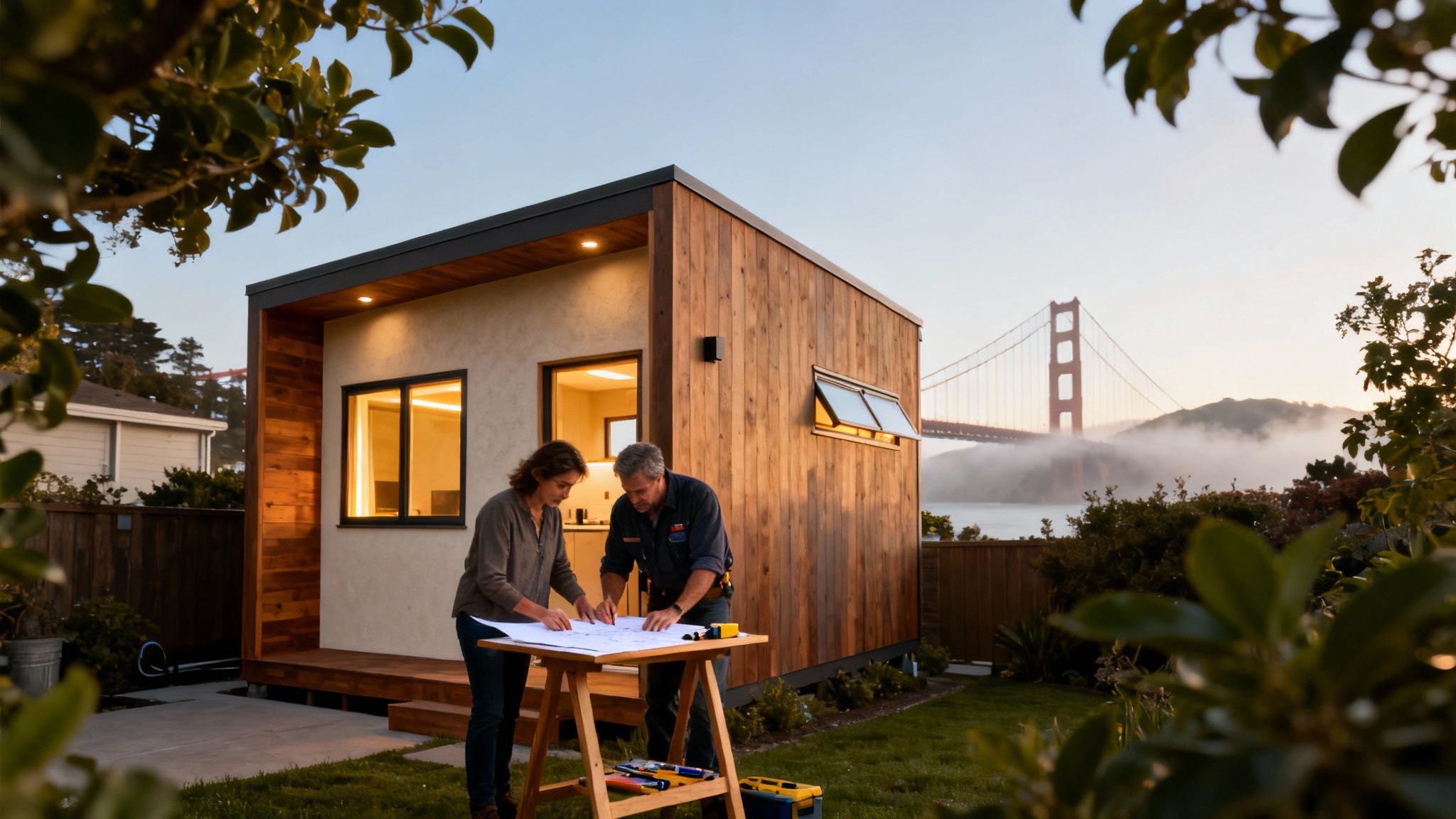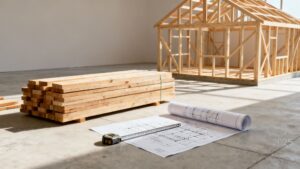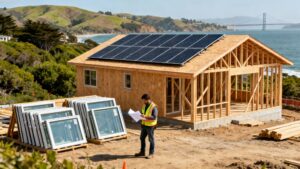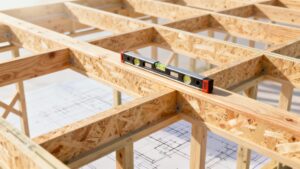Thinking about adding an ADU in the Bay Area? You're not alone. Accessory Dwelling Units (ADUs) are surging in popularity across cities like Berkeley and Oakland, driven by housing demand and new state incentives.
But before you start building, it’s important to plan. A successful ADU project requires understanding local zoning laws, setting a realistic budget, and choosing the right materials for a home that is compact but built to last. Planning these key areas first is the secret to a smooth project that adds real value to your property.
Why Bay Area Homeowners Are Building ADUs

ADUs are popping up in backyards all over the Bay Area. This trend is a smart response to our region's high housing costs and the need for more flexible living spaces. Homeowners are building ADUs to generate rental income, house family members, or increase their property value.
The ADU boom has been fueled by both the housing crunch and new state laws that make permitting easier. According to the Terner Center for Housing Innovation at UC Berkeley, nearly one in five new housing units in California is now an ADU. This shows a big shift toward building smaller, smarter homes on existing properties.
Why Are ADUs So Popular in the Bay Area?
For many families, an ADU is the perfect solution for multigenerational living. It allows aging parents or adult children to live close by while still having their own space. This offers both support and independence.
Others are building ADUs to generate rental income. In a high-cost area like the Bay Area, a steady check from a backyard rental can be a powerful financial tool. The way how we live, work, and play at home is evolving, and ADUs provide the flexibility many of us need.
These versatile little homes serve all kinds of other practical purposes, too:
- A Dedicated Home Office: A quiet, separate space to work without distractions from the main house.
- A Private Guest Suite: A comfortable spot for visiting family and friends that gives everyone their own space.
- A Creative Studio: An inspiring workshop for artists, musicians, or anyone needing a dedicated place for their craft.
Ultimately, building an ADU is a serious investment in your property's future value. If you're considering an ADU, start by planning for material performance, durability, and code compliance. This is especially important in the Bay Area’s varied microclimates.
Understanding Bay Area ADU Rules and Regulations
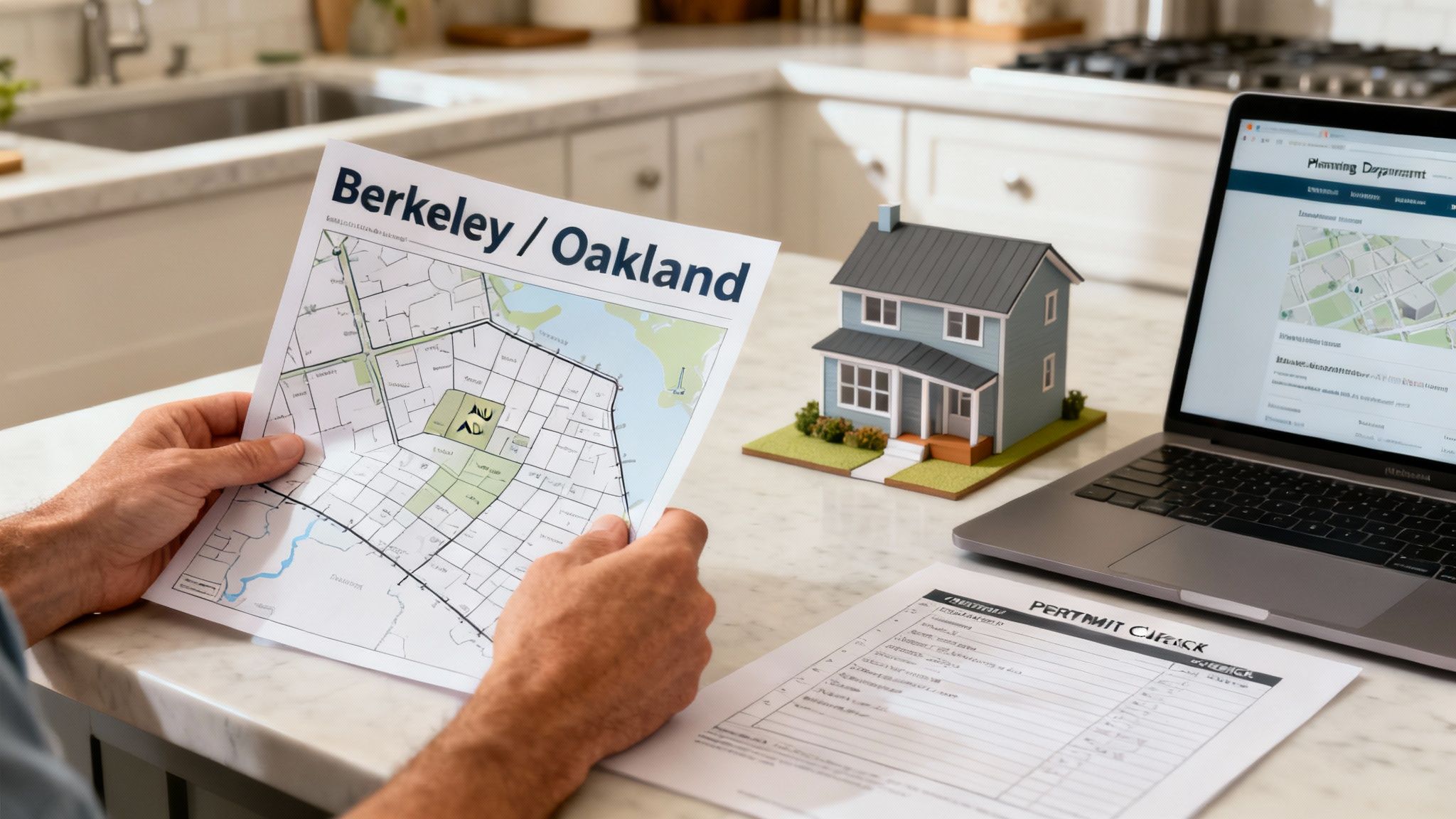
Before you can start building, you have to understand the rules. The legal side of building an ADU in the Bay Area can feel complex, but it’s manageable once you know how the system works. Think of it as two layers: California state law sets the basic rules, and your local city ordinance adds its own specific requirements.
In recent years, California has passed laws to make building ADUs easier. These laws create a foundation that every city must follow. However, each city, from Berkeley to San Francisco, can fine-tune those rules to fit its community.
State Laws vs. Local Ordinances
State laws provide the minimum standards that all cities must adopt. They cover big-picture items like permit review times and limiting how restrictive cities can be.
Local ordinances are where you’ll find the specific details for your project. A city like Berkeley might have different rules for height limits or architectural styles compared to Oakland. This is why your first stop should always be your local planning department.
Key Takeaway: While California has simplified the ADU process, your local city's planning department is your ultimate source of truth. Always verify their specific requirements for zoning, setbacks, and design before committing to a plan.
Core Concepts You Need to Know
When you start digging into local rules, you’ll see some specific terms. Getting familiar with this vocabulary will help you have a smoother process.
- Zoning: This determines if you can build an ADU on your property. Thanks to state laws, most single-family and multi-family lots are now eligible for at least one ADU.
- Setbacks: This is the required distance between your ADU and your property lines. State law now mandates a minimum of four-foot side and rear setbacks, which is a big help for smaller lots in the Bay Area.
- Height Limits: This dictates how tall your ADU can be. The standard is typically 16 feet for a detached, single-story unit, but some cities allow for taller structures.
- Parking Requirements: This used to be a major hurdle. State law has now eliminated parking requirements for most ADUs, especially if the property is near public transit.
To make sure your ADU project is fully compliant, it helps to understand the bigger picture of building regulations. This guide on Navigating Building Codes and Regulations provides helpful context.
Finding the Right Information
The best first step is to go to your city's official planning department website. Look for a dedicated ADU section, which often includes handbooks and checklists. To help you pull together all the necessary documents, our team has created a comprehensive building permit checklist.
Consulting with an architect or a contractor with ADU experience in your city is also a smart investment. Their local knowledge can help you avoid common problems and keep your project moving forward.
How to Create a Realistic Bay Area ADU Budget
Figuring out the real cost of an ADU in the Bay Area is a critical first step. A realistic budget is a detailed game plan that maps out everything from design fees to the final coat of paint. Building an ADU here means planning for some of the highest construction costs in the nation.
To get started, split your budget into two parts: soft costs and hard costs. Soft costs are planning and service fees, while hard costs cover the actual construction—the labor and materials.
Breaking Down Soft Costs: The Planning Phase
Soft costs are all the fees you pay before construction begins. They often account for 15-25% of the total project cost.
These usually include:
- Architectural and Design Fees: What you pay an architect or designer to create the blueprints.
- Permit and Impact Fees: Money paid to your local city to review, approve, and inspect your plans.
- Engineering Fees: Costs for specialists like structural or soil engineers.
- Surveying Costs: Fees for a land surveyor to map your property lines.
These upfront expenses are an investment in a smooth project. Cutting corners here often leads to expensive delays later.
Understanding Hard Costs: The Building Phase
Hard costs are what most people think of as the construction budget. This includes lumber, concrete, roofing, and the skilled labor needed to put it all together. Hard costs in the Bay Area are high due to labor rates and the need for quality materials that can handle local microclimates.
In 2024, the average cost to build a detached ADU in the region is between $400 and $500 per square foot. Some high-end projects can reach $525 per square foot or more. A typical 750-square-foot ADU could cost around $375,000 to build.
How to Finance Your ADU Project
Once you have an estimated cost, the next step is figuring out how to pay for it. Homeowners in the Bay Area have several options to fund their ADU projects.
- Cash-Out Refinance: Refinance your current mortgage for a larger amount and use the extra cash.
- Home Equity Line of Credit (HELOC): A line of credit that draws against your home's equity.
- Construction Loan: A short-term loan specifically for building projects.
- Renovation Loan: Options like the FHA 203(k) loan let you roll the ADU cost into your mortgage.
For practical tips on keeping your project on track financially, our guide on https://truittandwhite.com/construction-budget-management offers valuable strategies. You can also explore these smart strategies for reducing construction costs.
Designing a Smart and High-Performance ADU
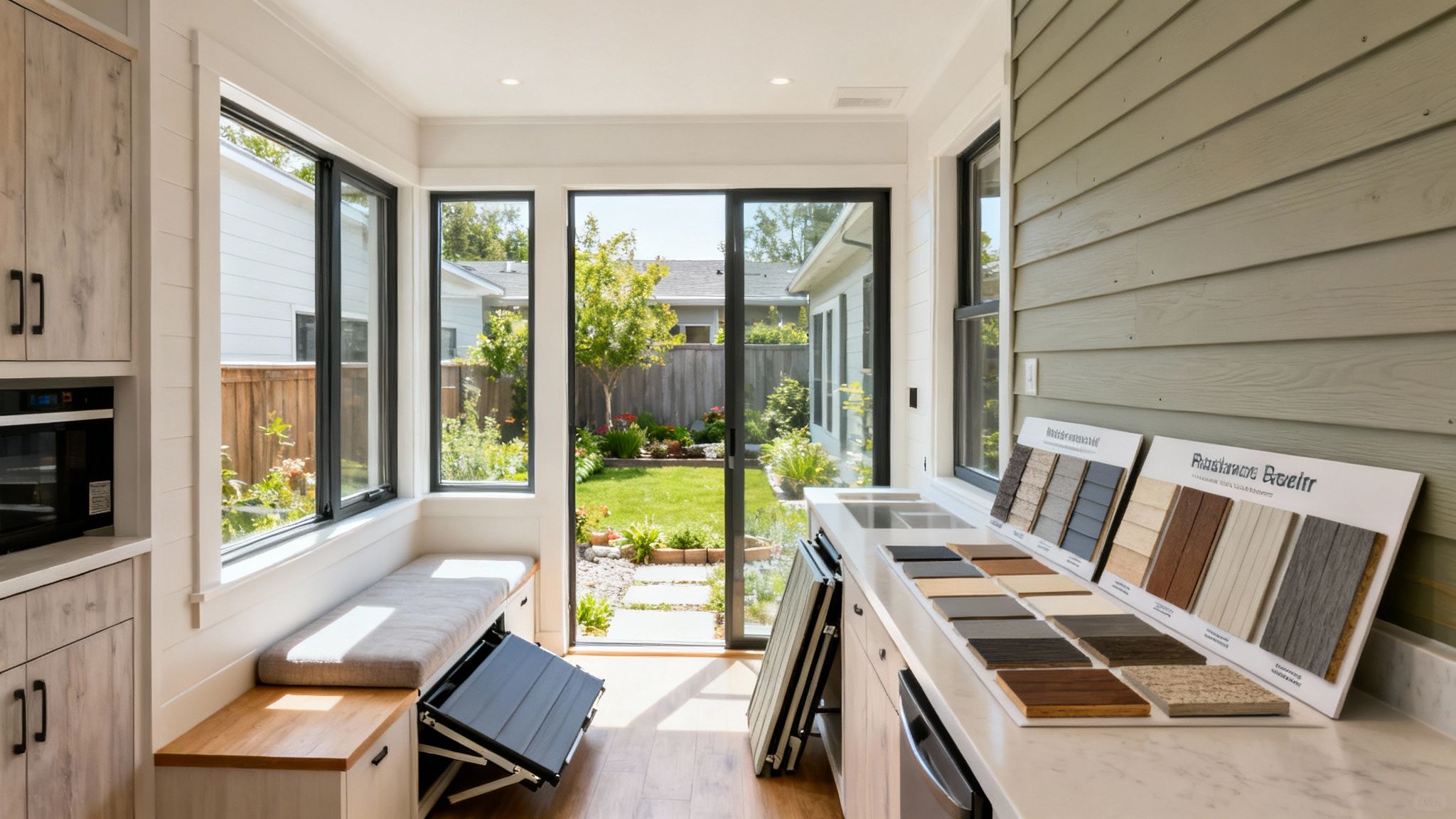
A great ADU is a masterclass in smart design and material choices. When every square foot counts, your strategy must maximize both the feel and the function of the space. The goal is to design a space that feels open and livable, not cramped.
Clever design can make a small footprint feel surprisingly spacious. But it’s the right building materials that will ensure it stands up to the Bay Area’s diverse microclimates for years to come.
How to Maximize Space in a Small Footprint
Making a small space feel big is an art based on practical design. The key is creating an environment that feels open and inviting. Start with an open-concept layout that combines the kitchen, living, and dining areas.
Here are a few other strategies to enhance small-space living:
- Embrace Natural Light: Large, high-performance windows and glass doors are your best friends. They brighten the space and create a connection to the outdoors.
- Incorporate Smart Storage: Plan your storage from day one. Think built-in shelving, under-stair cabinets, and multi-functional furniture.
- Choose a Light Color Palette: Lighter colors on walls and ceilings reflect light, making any room feel more airy and expansive.
Selecting Materials for Bay Area Weather
Your material choices are where good design meets long-term durability. This means picking products that can handle everything from San Francisco's fog to the dry heat of inland areas. This is where local expertise really pays off.
Key Consideration: The long-term value of an ADU is tied to its construction quality. Investing in high-performance materials upfront leads to lower utility bills and less maintenance.
When you're building in the Bay Area, you have to prioritize materials that deliver performance and energy efficiency.
Essential Materials for a Bay Area ADU
Choosing the right components is critical for building an efficient and resilient structure. This table highlights key material categories and why they are important for ADU projects in our region.
| Material Category | Key Considerations | Why It Matters for an ADU |
|---|---|---|
| Windows & Doors | Look for good U-factor and SHGC ratings for thermal performance. Consider space-saving styles like sliding or casement windows. | High-performance units reduce energy loss, lower heating and cooling costs, and provide soundproofing—a big plus for backyard settings. |
| Framing & Insulation | Choose between wood framing with high-R-value insulation or advanced systems like Structural Insulated Panels (SIPs) for energy efficiency. | A well-insulated building is crucial for comfort and Title 24 compliance. It keeps the small space comfortable year-round. |
| Siding & Roofing | Select durable, low-maintenance materials like fiber cement siding and quality roofing that can withstand moisture and sun. | These materials protect the ADU from the elements, preventing costly water damage and reducing the need for frequent repairs. |
For builders interested in advanced framing, you can learn more about how Structural Insulated Panels offer a builder's guide. The right materials don't just build a structure; they create a comfortable and lasting home.
Calculating the Return on Your ADU Investment
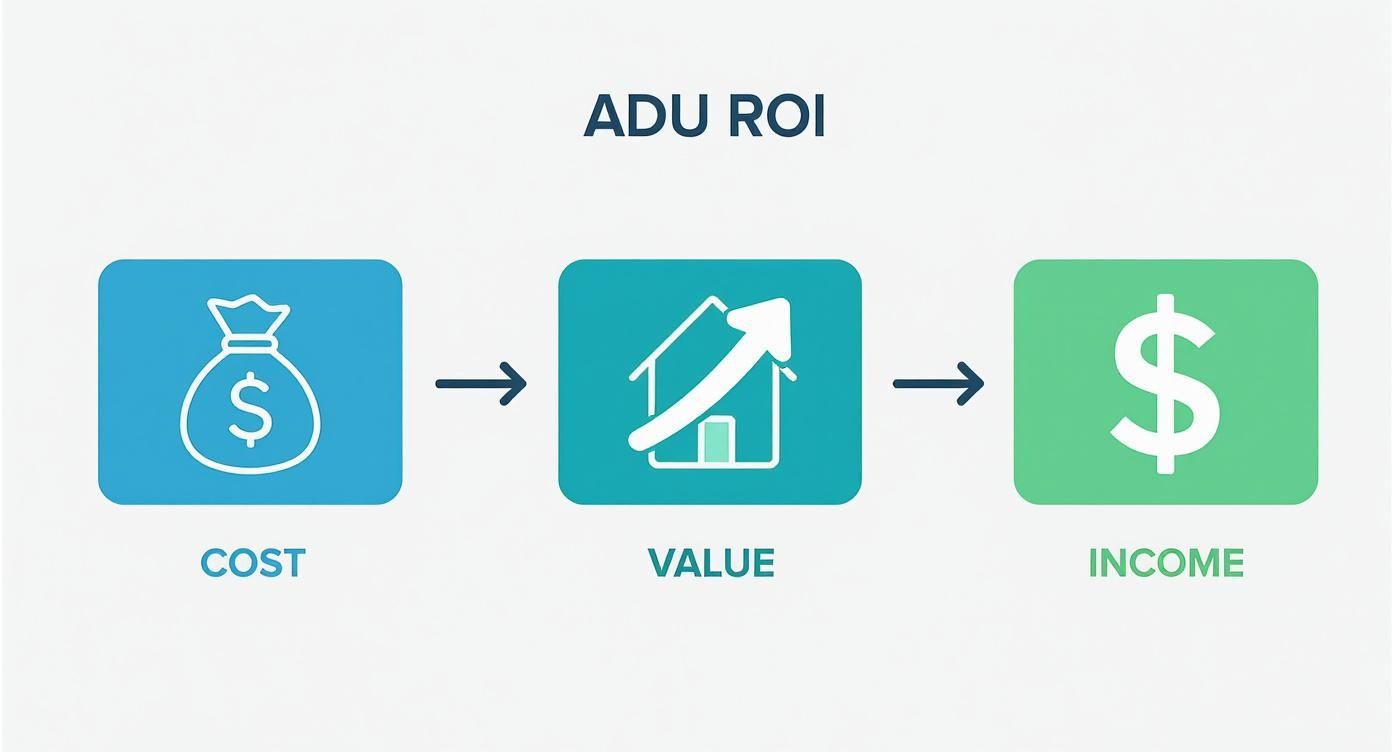
An ADU is more than just another building; it’s a powerful financial asset. When you’re thinking about an ADU in the Bay Area, understanding its Return on Investment (ROI) is key. This means weighing the upfront costs against the long-term gains.
The ROI of an ADU comes from two main places: a boost in your property's value and the potential for steady rental income. Together, these factors can make an ADU one of the smartest financial decisions a Bay Area homeowner can make.
How an ADU Boosts Your Property Value
Adding a permitted living space to your property instantly increases its market value. In a competitive real estate market like ours, an ADU is a highly sought-after feature. Buyers see a home with an ADU as having built-in flexibility.
Recent data shows that properties with ADUs often appraise for significantly more than those without. This added value makes your home a stronger long-term investment.
How an ADU Generates Rental Income
The other side of the ROI coin is rental income. With high demand and limited housing supply, rental rates in cities like Berkeley and Oakland remain strong. A well-designed ADU can generate significant monthly cash flow.
To get a good estimate of potential earnings, research current rental rates for similar-sized units in your neighborhood.
- Studio or One-Bedroom ADU: Perfect for single professionals or students, these units are always in high demand.
- Two-Bedroom ADU: This option appeals to couples or small families, often commanding a higher rental price.
High-quality finishes and energy-efficient features can also justify a higher rent. Investing in durable materials and high-performance windows lowers utility costs and adds to the unit's appeal. You can learn more about if energy-efficient windows are a cost-effective choice for your build.
Your Bay Area ADU Action Plan
Ready to turn your ADU idea into reality? Let's break down the essential first steps into a simple roadmap to get your project off the ground. Building an ADU in the Bay Area is a serious project, but it's more manageable when you tackle it one step at a time.
Having a solid plan is what separates a smooth project from a stressful one. The right experts in your corner make all the difference.
Pre-Construction Checklist for Your ADU Project
Before you break ground, run through these key steps. Getting this foundation right will set the tone for the entire project.
- Define Your Goals: First, decide what the ADU is for. Is it a rental unit, a space for family, or a home office? Your answer will guide every decision.
- Research Local Rules: Go straight to your city’s planning department website. Whether you're in Berkeley or Oakland, you need to know the exact zoning rules, setbacks, and height limits.
- Create a Detailed Budget: Your budget needs to include both soft costs (design fees, permits) and hard costs (labor, materials). Also, include a contingency fund of 15-20% for surprises.
- Assemble Your Team: Look for architects, designers, and contractors with a proven track record of building ADUs in your city. Their local knowledge is invaluable.
- Plan Your Materials Early: Choose your windows, doors, and siding early. Working with a reliable supplier like Truitt & White ensures you get materials that perform well and arrive on time.
We’re Here to Help You Build Smarter
Truitt & White is uniquely equipped to support ADU builders with high-quality materials tailored for small, efficient builds. Our team provides expert advice on everything from space-maximizing doors and windows to compliant lumber and weatherproofing products. With deep local knowledge, we help simplify complex builds.
Ready to start your ADU project? Visit our Berkeley showroom for personalized recommendations and expert advice designed for Bay Area building conditions.
Frequently Asked Questions About Bay Area ADUs
How much does an ADU cost in the Bay Area?
The cost to build an ADU in the Bay Area typically ranges from $200,000 to over $500,000. The final price depends on the size, design complexity, site conditions, and quality of materials used. On average, you can expect to pay between $400 and $500 per square foot.
How long does it take to get ADU permits in Berkeley or Oakland?
While state law requires cities to approve or deny ADU permit applications within 60 days, this timeline starts only after the application is deemed "complete." Incomplete paperwork or complex site issues can cause delays. Working with an experienced local professional can help you avoid common pitfalls and speed up the process.
Can I build an ADU on my sloped lot?
Yes, you can build an ADU on a sloped lot, but it requires careful engineering and site preparation. Expect higher costs for foundation work, excavation, and potentially retaining walls. A thorough site evaluation by a qualified professional is the best first step to understand the challenges and opportunities.
What are the best windows for a small ADU?
For a small ADU, choose windows that maximize natural light and save space. We recommend large, high-performance windows to make the space feel bigger and more open. Styles like casement or sliding windows are ideal because they don’t swing into your living area or block outdoor walkways.
How do I find a trustworthy contractor for my ADU project?
The best way to find a reliable contractor is through referrals from trusted sources like local architects, designers, or material suppliers. Always check that their license is active, ask for proof of insurance, and review their portfolio to see examples of ADUs they have built in your city.
Ready to get your ADU project started with the right materials and advice from people who know Bay Area building? The team at Truitt & White has been helping local builders get the job done right for decades. Swing by our Berkeley showroom or get in touch with our team for recommendations tailored for our unique local conditions.


